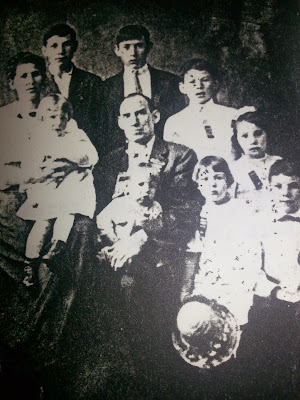I've been thinking a lot lately about my Mom and her Mom's family. I knew my grandmother, Gan; as we called her, had been through the Great Flu Epidemic back in 1918.
I, also, knew her Dad, Sidney, died October 27 of that year.
In researching the Great Flu Epidemic the statistics indicate October 27, 1918 was the day the largest number of people died as a result of the flu epidemic in one day.
In retrospect I always found myself thinking how the death of my great-grandfather effected the women in his life.
I know my great-grandfather's death left a widow (at 38 y.o.) with 11 children, having already lost two of them. She had lost a son, Brynley, in 1907 at the tender age of three and an infant not quite two months old in 1914.
Sidney Davis family in 1913 at Kennywood Park, Pittsburgh, PA
Now she was left a widow with a 21 year old WWI soldier son, a 20 year old son, a 17 year old son, a 15 year old son, a 12 year old daughter, a 10 year old daughter, an 8 year old daughter, a 6 year old son, a three year old son, a 22 month old daughter and a 9 day old son.
She had her hands full and she was on her own. Her parents and both sets of grand-parents were deceased. What a struggle her and her children's lives must have been. She was thrust into a life without an income. Her perfectly healthy working husband got the Spanish flu and died! How many of the children that lived through the flu epidemic were sick? Did she suffer the flu herself? I'm sure some of the children old enough to work helped out financially and the older girls helped with youngest children but I can't fathom how she did it. How many were still in school? How many could actually find employment and help with the finances? There was no pension, no social security benefits for her underage children, how did she make ends meet? I know my Mom always told me she came from strong pioneer stock, maybe that was it. My great-grandmother's family had been here for almost 200 years at the time of the Great Flu Epidemic.
Sidney's mom, Mary, had just lost her husband of 49 years, William, 9 months ago. Mary, still grieving her husbands loss, loses her 44 year old son, with 11 children. She was dealt another blow by her first son's death at 49 years seventeen days later on November 13, 1918. At the age of 70 years she was living under the roof of two of her coal miner sons, a pregnant daughter-in-law and two grandchildren. Mary will go on to lose a 39 year old daughter, Ida, with in a year. Ida leaving 3 of her children, girls ages 12 years to 17 years old motherless and fatherless and her three children from her second marriage with out a mom. (The oldest being 6 years of age and the youngest being 17 months old.) Did the three older girls live with their step dad and their 3 other siblings and help raise them after Mom died? (I know Ida was a milliner and a seamstress so with her death they had less income. )
The oldest girl became a nurse and I don't know if she ever married. The 5 year old was hit by a train at 10 years of age and died. The rest of the kids went on to marry and have their own families.
That brings up the sisters of Sidney: Edith and Ida lost their dear brother. (Ida dies in October 3, 1919)
Next comes the daughters: Margaret, Kathryn, Neva and Marie lost their Dad. How emotionally and financially devistating would that be? They had been the first in their town to have a telephone in their home, now luxuries like that would be unattainable.
None of the children were married yet so when the widow became a grandmother the grandchildren knew no grandfather.
Back in 1918 life was hard. In looking at census records you can see a definative pattern of babies showing up on the scene within a year or two of marraige and then about every two years.
Yes, many didn't make it to adulthood but that the doesn't belittle the loss. Losing a viable productive husband with 11 children ages 9 days to 21 years of age had to be mind numbing, but 'pick yourself up and get on with it' would be the only choice the working class family had back then...
I
honor all those who did so.
Thank you for reading our story. Feel free to add anything or ask anything.






